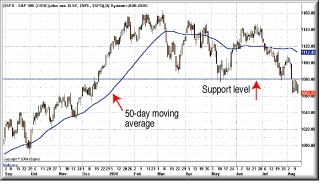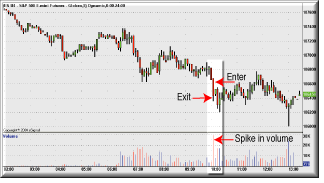How did the markets open today? For the last four months, I've been watching market movements in the eminis. After all, they are a popular trading instrument, and one that provides the opportunity to make a few points in a trading day. This, along with my strong belief that you should only trade a market that you understand, piqued my interest in paper-trading them. Let me walk you through a trading day.
I've set a few guidelines I intend to follow. The first thing I look at before trading anything is the daily chart of the Standard & Poor's 500 index, since it closely resembles the movement in the eminis. As you can see from Figure 1, the S&P 500 is currently trading below its 50-day moving average. In addition, prices have broken below a critical support level at 1080. This could mean a further decline in prices to levels lower than seen on this chart. With this negative sentiment, I am not even going to open a long position to make a trade. All charts point to a downward-trading market, which means great opportunities in shorting.

FIGURE 1: S&P 500 INDEX (DAILY CHART). Prices are below the 50-day moving average, which has started trending down. Further, prices broke below a major support level.
So with that in mind, I bring up a five-minute intraday chart of
the S&P mini contract, and sit back to wait until a short trading opportunity
arises. Based on my observations and paper-trading results, I learned early
on that discipline is important and there's a reason you set rules. If
for whatever reason a trading opportunity doesn't arise, it's not a big
deal. There's always tomorrow. What is important is that you stick to your
trading rules.
To be a good trader, you must have patience. Throughout the trading day you will find yourself waiting for that trading opportunity. I always wait for high momentum, although I sometimes miss it, mainly because I can't have my eyes glued to the screen. When I do catch a move, I need to make a quick two points.
Given that I live on the West Coast, I find it difficult to watch the markets at the open. Instead, I focus on trading activity after the traders return from lunch. This gives me time to try to understand the market behavior for the day and, based on the average trading range for the day, determine where to place my stop-loss orders.
TODAY'S TRADE
On August 12, 2004, the markets showed weakness in the first hour of trading. At 10:05 am (PT), I noticed an increase in the downside momentum on the September emini contracts. As a result, I entered a short position at 1066. Note the spike in volume. This tells me that momentum is increasing. Within three minutes I exited the trade at 1064 (see Figure 2). Why did I exit at that point? For starters, my profit objective is to make two points per trade. There have been trades where I have held on for more, but only when I saw that momentum was continuing to increase. I didn't see that here, and so I made my exit after that two-point objective was reached. For one contract, that's $100. When you subtract the commissions and fees, this may not seem like much, but it adds up. Now it's just a matter of building up enough cash to trade more than one contract.

FIGURE 2: S&P 500 INDEX (DAILY CHART). Prices are below the 50-day moving average, which has started trending down. Further, prices broke below a major support level.
What if the position had turned against me? Before entering the trade, I had determined my stop-loss point. I noticed from looking at the intraday chart that the 1067 level was a good resistance level, and so I would have placed my stop at 1067.25. That's a relatively wide margin, but given the conditions at the time I placed my trade, I thought I'd be safe enough if prices didn't move above the 1067 level.
I probably would have made a larger profit if I had held onto that short position for a while longer, but why continue watching the markets? Closing a position on a trade in which you followed your trading rules means a job well done.
-Jayanthi Gopalakrishnan, Editor
Originally published in the October 2004 issue of Technical Analysis of STOCKS & COMMODITIES magazine. All rights reserved. © Copyright 2004, Technical Analysis, Inc.
Return to October 2004 Contents